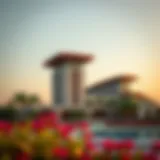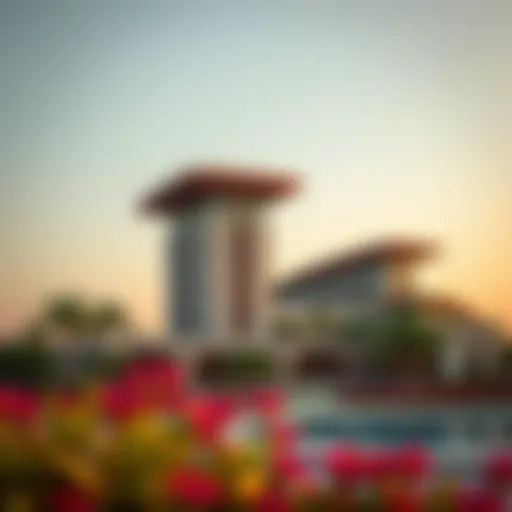Comprehensive Overview of the Dubai Red Line Metro Map
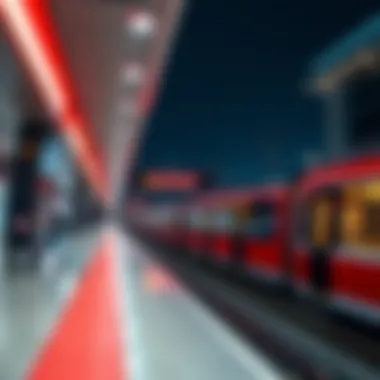
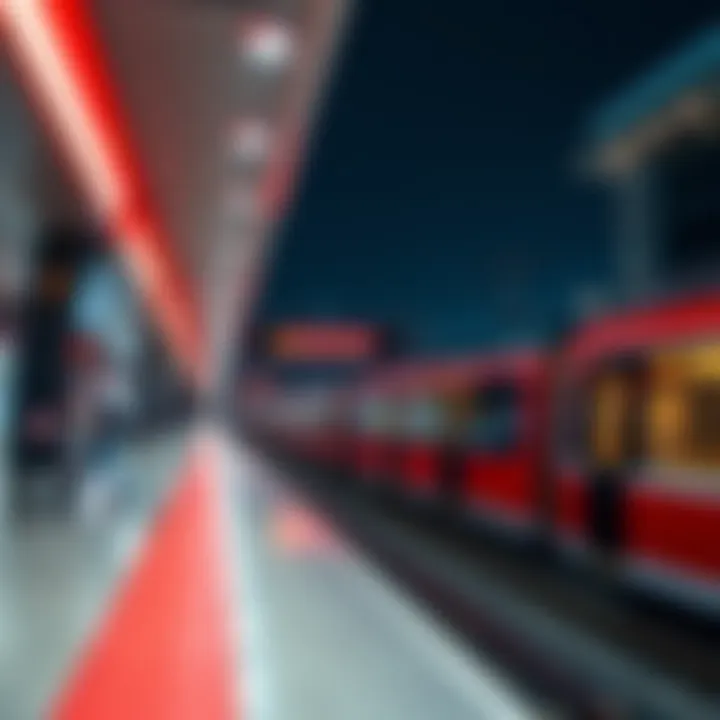
Intro
Dubai's modern skyline is a sight to behold, but the real marvel often lies beneath the bustling surface. The Dubai Red Line Metro exemplifies this, functioning not just as a means of transport but as a vital thread in the city's intricate fabric. With each station carefully placed, it creates an artery connecting key districts and neighborhoods, influencing both movement and growth in the city. Understanding this metro system is essential for investors, homebuyers, agents, and analysts looking to navigate the changing landscape of Dubai's real estate.
The Red Line stands out, linking vital locales from the heart of Dubai to its sprawling suburbs. Through this article, we will traverse the stations along this line, examine the real estate trends that have emerged as a result, and delve into the socio-economic impacts seen in various neighborhoods. This lays the groundwork for insightful analyses on property investments and living conditions for those eyeing opportunities near these metro stations.
Market Trends
Current Market Analysis
The current real estate market along the Dubai Red Line has exhibited a blend of resilience and transformation. Metro stations like Dubai Mall, Burj Khalifa, and Jumeirah Lakes Towers have seen an uptick in property values, as both end-users and investors scramble to secure their slice of accessible urban living. The vicinity of the metro, offering easy connectivity to commercial areas and leisure spots, commands premium prices on properties, making them a hot commodity in real estate discussions.
Savvy investors often look for areas that are on the verge of gentrification or significant development. The emergence of new businesses, restaurants, and entertainment options along these metro corridors typically signals a vibrant community, attracting both tenants and buyers. Moreover, government initiatives to boost public transport infrastructure lend additional credence to this trend.
Future Projections
Looking ahead, experts anticipate that the Red Line will continue to reshape the real estate landscape. While existing hotspots will no doubt maintain their attractiveness, newer areas linked by future metro extensions may even trend more favorably as the city grows. Anticipated projects, such as the Dubai Expo 2025, are likely to further amplify interest in surrounding neighborhoods.
"As the Red Line expands its reach, local property markets stand to benefit significantly, aligning with the overall vision of Smart Dubai."
With population growth projected to continue, coupled with an influx of business opportunities, the Red Line's impact on real estate is poised to deepen. Investors should keep a close eye on developments and upcoming station openings, as these can create ripples across property values in adjacent areas.
Property Insights
Neighborhood Comparisons
A diverse mix of neighborhoods flanks the Red Line, each with its unique allure. For instance, the area of Dubai Marina boasts luxury high-rises and is popular among expatriates and tourists alike. In contrast, sections like Al Barsha offer a more laid-back vibe with family-friendly amenities. An astute buyer should weigh these factors carefully.
- Dubai Marina: High-end living, close proximity to nightlife, ideal for young professionals.
- Al Barsha: Family-oriented, more affordable options, close to schools and parks.
- Jumeirah Lakes Towers (JLT): Commercial and residential blend, appealing to those wanting easy access to work-life balance.
Property Types Explained
When it comes to property types near the Red Line, homebuyers encounter a spectrum ranging from luxury apartments to modest studios. Each option speaks to different demographics, whether they’re affluent expatriates, local professionals, or families seeking stable roots.
- Apartments: Dominant in areas like Dubai Marina, offering a range from spacious penthouses to compact units.
- Villas: More prevalent in neighborhoods like Al Barsha, appealing to families and individuals desiring larger living spaces.
- Commercial spaces: Found near major metro stops, catering to businesses wanting to capitalize on foot traffic.
As the Red Line continues to evolve, understanding these dynamics equips investors and potential homeowners with the insight they need for prudent decision-making.
For further information, please consult sources like Wikipedia, Britannica, and local real estate market reports on Reddit regarding trends and community insights.
Preface to the Dubai Red Line Metro
The Dubai Red Line Metro is not just a public transportation system; it is a vital artery of movement that connects a bustling city. The line eases the daily commute for countless residents and visitors, making it essential in a rapidly developing urban environment. Its immersive integration into Dubai's intricate urban fabric transcends mere transport—it shapes the very essence of mobility and convenience within the emirate.
Understanding the Red Line's Role
The Red Line runs a considerable stretch across Dubai, encompassing some key districts and notable landmarks. As the backbone of the Dubai Metro system, it serves as a lifeline for those navigating the city. By connecting the Dubai International Airport to the urban heart of the city, the Red Line plays a pivotal role for both locals and tourists alike. With its extensive network, it facilitates easier access to commercial resorts like Dubai Mall and residential areas such as Jumeirah Lakes Towers. This access transcends traditional commuting; it enriches life by connecting people with culture, leisure, and work.
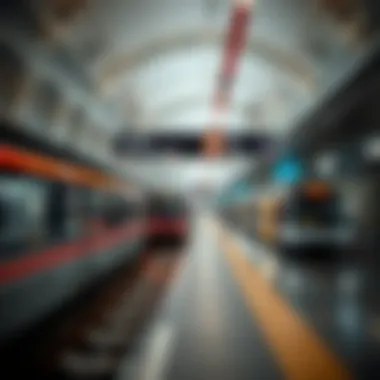
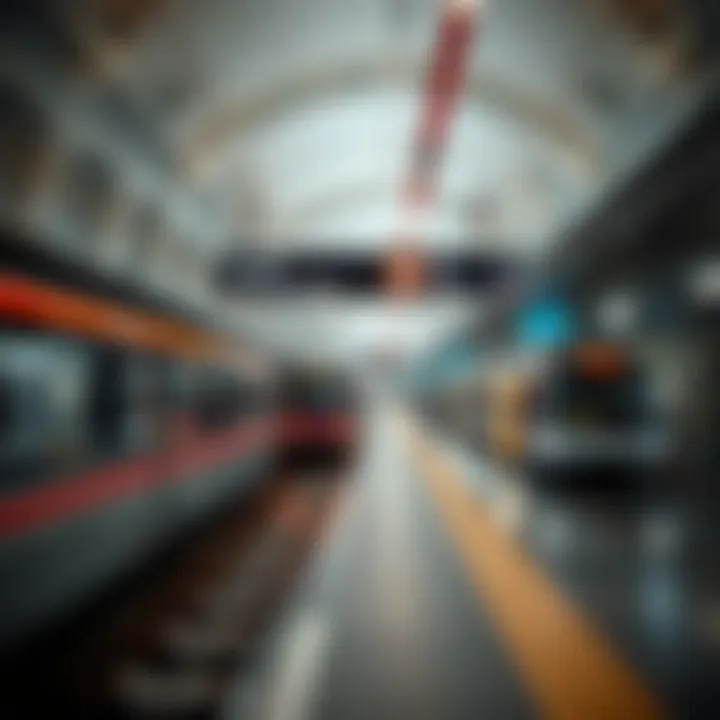
Moreover, the Red Line is not isolated from the surrounding infrastructure but closely integrated with buses, taxis, and water transport. This multi-modal connectivity boosts the utility of public transport, ensuring that commuters have multiple pathways to their destinations. By minimizing reliance on personal vehicles, the metro reduces traffic congestion, making it a widely favored option among the populace.
Historical Context and Development
The conception of the Dubai Red Line is anchored in the city’s ambition to embrace modernity while accommodating its exponential growth. The first phase of the metro was inaugurated in 2009, marking a significant milestone in transport evolution in the region. As the city burgeoned in the early 2000s, the need for a reliable, efficient public transit system became glaringly obvious. The Metro's construction was a response to this pressing demand and a strategic move to enhance Dubai's global standing.
Building a metro in the sandy landscape required innovative engineering solutions. For instance, the underground sections were meticulously designed, sometimes involving extensive land excavation and tunnel boring. This ambitious project, spearheaded by the Roads and Transport Authority, not only showcased engineering prowess but also highlighted a commitment to sustainability—a modern transportation system designed to be energy-efficient and future-proof.
In its infancy, the Red Line faced challenges from economic fluctuations and logistical hurdles. However, by consistently pushing through adversity, the initiative transformed into one of the most celebrated developments in metropolitan transport. Its ongoing evolution is a testament to Dubai's resilience and foresight, making it a compelling subject of study for investors and urban analysts alike.
Detailed Examination of the Red Line Map
A detailed understanding of the Dubai Red Line Metro can provide invaluable insights for various stakeholders, including investors, homebuyers, and city planners. This section will dive into various facets of the Red Line map, revealing how it serves as a pivotal link in the city’s transportation network. Knowing where the stations are, their features, and their interconnections can shed light on the potential for real estate and urban development.
Visual Representation of the Red Line
The visual representation of the Red Line is not just a simple map; it's a comprehensive view of the city’s urban fabric. Comprising 29 stations stretching across 52 kilometers, this line helps navigate through densely populated and popular areas. It cuts across the traditional boundaries of urban zones, showing clear pathways from one end of the city to the other.
Travelers can spot key landmarks like the Burj Khalifa and Dubai Mall with ease, all thanks to the clear symbols and colors used in the design. What’s more, the layout of the map harmonizes well with traditional Dubai geography, making it user-friendly for tourists and residents alike. The colors differentiate various lines, while icons represent major attractions.
Key Stations and Their Features
When evaluating the key stations along the Red Line, each one plays a distinct role in enhancing connectivity and usability. Some notable stops include:
- Burj Khalifa/Dubai Mall Station: This is a major destination that transforms the station into not just a transportation hub, but a social and cultural magnet.
- Business Bay Station: A hot spot for commercial activity, it supports Dubai's rapid economic growth.
- Deira City Centre Station: Provides access to shopping and dining options, effectively bridging traditional and modern Dubai.
Each station has unique features, including retail spaces, waiting lounges, and digital information displays that provide real-time updates. They meet not only the needs of commuters but also cater to leisure and business activities, boosting foot traffic in the areas surrounding them.
Integration with Other Modes of Transport
The integration of the Red Line with other modes of transport enhances its utility significantly. Connecting seamlessly with the Dubai Tram and bus networks, the metro ensures that travelers experience a smooth transition from one form of transportation to another.
- Buses: More than 60 bus routes intersect with the Red Line stations, offering extensive coverage across the city.
- Trams: The tram system in areas like Dubai Marina and JLT taps into the metro, creating a more holistic transport experience.
- Taxis and Ride-Sharing Services: Proximity to the metro stations allows quick access to various taxi services and rideshare apps, further facilitating door-to-door travel.
By aligning multiple transport options, the Red Line effectively minimizes travel time and enhances the commuting experience across Dubai. It exemplifies a well-thought-out urban planning strategy that prioritizes ease of access and mobility for everyone.
"A well-integrated public transport system like the Dubai Red Line fosters not only convenience but also economic growth and urban development." - Urban Planning Expert
This examination of the Red Line map serves as a foundational understanding for various audiences, highlighting key stations, their unique offerings, and how they fit into the larger picture of Dubai's evolving transport landscape.
Station-by-Station Analysis
Analyzing the Metro stations along the Dubai Red Line brings to light crucial aspects about the urban landscape and public transit dynamics of the city. Each station serves not merely as a transport stop but as a pivotal center influencing economic activities, real estate trends, and community interactions. Understanding this infrastructure heightens awareness of investment opportunities and highlights the socio-economic fabric that improves livability along the line.
Major Hubs and Their Characteristics
One cannot overlook the strategic importance of the major hubs along the Red Line. These are not just stops but thriving activity centers that embody the vibrant spirit of Dubai. Stations like Burj Khalifa/Dubai Mall, for instance, are situated near some of the city’s most iconic attractions. The Burj Khalifa station offers easy access to the tallest building in the world, along with the sprawling Dubai Mall, which itself is a magnet for tourists and shopping enthusiasts.
- Burj Khalifa/Dubai Mall Station: This hub sees high foot traffic, thanks to its proximity to luxurious retail experiences and cultural landmarks. Its affluent clientele influences surrounding property values.
- Union Station: A connectivity powerhouse, Union Station is essential for transfers between the Red and Green Lines. Its design facilitates smoother commutes and elevates nearby commercial properties.
- Deira City Centre: Known for its retail hub, this station attracts locals and visitors alike, supporting various businesses and uplifting the area’s appeal.
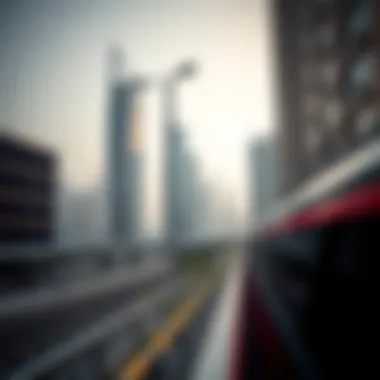
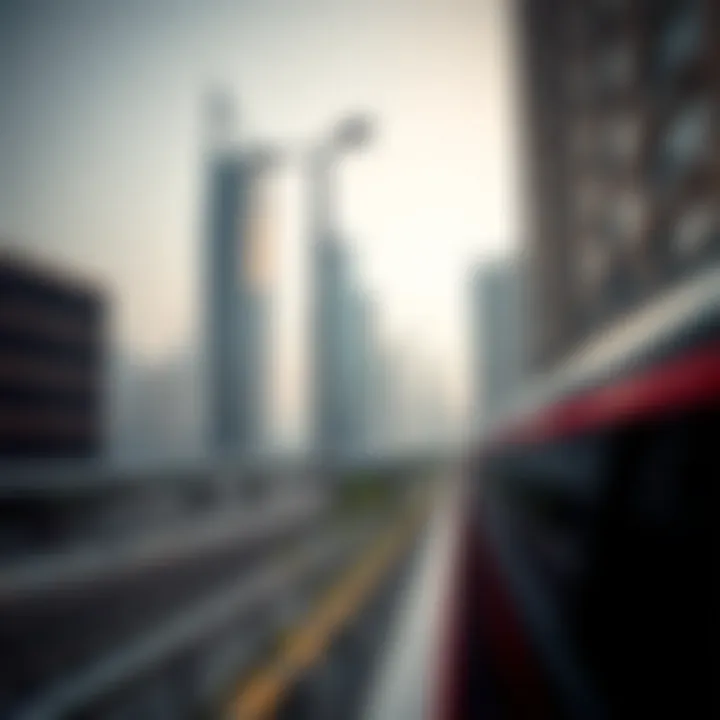
Understanding the character of these hubs can assist investors and homebuyers in making informed decisions about properties in their vicinity. Areas near major stations often witness surges in property values driven by heightened demand.
Emerging Neighborhoods along the Line
As the urban landscape of Dubai continues to evolve, so too do the neighborhoods adjacent to the Red Line. For instance, areas like Business Bay and Dubai Marina are burgeoning with residential projects, making them appealing options for investors.
- Business Bay: This area has emerged as a center of commerce and lifestyle. The presence of the Red Line has made this once-quiet zone lively with eateries, high-rise apartments, and corporate offices, drawing professionals and young families.
- Dubai Marina: This waterfront landmark is often viewed as a favorite amongst expatriates. The metro's accessibility enhances its allure, promoting a convenient lifestyle without the necessity of a vehicle.
- Jumeirah Lake Towers: Surrounded by picturesque lakes, this locality is also reaping benefits from the metro, making it an attractive spot for those who appreciate scenic views while maintaining urban proximity.
Learning about these emerging neighborhoods can guide buyers and investors targeting growth areas showing promise in property appreciation and rental yields.
Accessibility Features at Each Station
Accessibility remains a cornerstone of public transport systems, and the Red Line excels in this regard. Each station is designed with a variety of features ensuring inclusivity for all demographics, including families, the elderly, and those with disabilities.
- Ramps and Elevators: Each station is equipped with ramps and elevators, making it convenient for wheelchair users and strollers alike.
- Clear Signage: Information is communicated effectively with multilingual signage, allowing non-Arabic speakers to navigate with ease. This is critical in a multicultural city like Dubai.
- Safety Measures: Regular maintenance checks ensure that elevators and escalators are safe and functioning properly. The design of platforms includes safety features that protect all passengers.
The commitment to accessibility reflects Dubai’s quote “open to all.” Understanding these features not only illustrates the city’s approach to inclusivity but also signifies the necessity for adaptive real estate and community infrastructures.
The Dubai Metro, with its Red Line, serves as a backbone of urban transit, demonstrating the city's commitment to modern transportation solutions while significantly shaping the real estate landscape.
When investors and prospective homeowners recognize these benefits, they can appreciate the broader implications of their choices in neighborhoods near metro stations.
Impact of the Red Line on Local Real Estate
The establishment of the Dubai Red Line Metro has dramatically reshaped the local real estate landscape, making it a pivotal element in both urban development and property investment strategies. Understanding its impact is essential for investors, homebuyers, and real estate professionals, as it directly relates to property values, accessibility, and community growth. With the Red Line serving as a backbone for commuting, it facilitates smoother access to various neighborhoods, ultimately influencing decisions around where individuals and families choose to live or invest.
Trends in Property Value Near Stations
Recent analyses indicate a noticeable increase in property values near Red Line stations. Properties located within a walkable distance, say about 500 meters, often experience a premium valuation compared to those farther away. This phenomenon can be attributed to the enhanced convenience offered by public transport access. Notably, areas like Dubai Marina and the Business Bay have seen property values swell, owing to their adjacency to Metro stations. Investors pulsating to this beat can look towards high-performing zones where the demand for rental properties is on the rise, as potential tenants increasingly prioritize accessibility in their housing choices.
Key factors influencing these trends include:
- Proximity to Work: Commuters favor areas near Metro stations to minimize travel time, which in turn increases demand for rentals and sales.
- Local Amenities: Neighborhoods adjacent to Metro stations, such as shopping centers and parks, see a surge in desirability, further driving up property prices.
- Urban Development Projects: Ongoing and planned developments around metro stations often bring in improvements that attract buyers.
Investor Insights: Best Areas to Buy
For investors keen on maximizing their returns, pinpointing the best areas to invest along the Red Line is crucial. Some hotspots include:
- Dubai Marina: A vibrant hub that expertly balances residential and commercial spaces, making it appealing for both short-term rentals and long-term investments.
- Al Jafiliya: A lesser-known gem, this area boasts growing interest due to new developments and improved connectivity.
- Sheikh Zayed Road: Often termed the lifeline of Dubai, it intersects the Metro, offering commercial and residential opportunities alike.
Investors should consider the stage of development in these neighborhoods. Areas in early development may be more affordable yet yield higher returns as infrastructure matures and accessibility enhances. Keeping an eye on upcoming stations can also provide early movers the advantage of snagging deals before prices surge.
Living Conditions and Lifestyle Adjustments
Relocating near the Red Line not only boosts property values but also adjusts living conditions in significant ways. Residents are increasingly drawn to neighborhoods with excellent transport links. For instance, people living around the Jumeirah Lakes Towers station enjoy not just transport convenience but also a variety of lifestyle options—from cafes to retail shops—all within walking distance.
Considerations for those moving to these areas include:
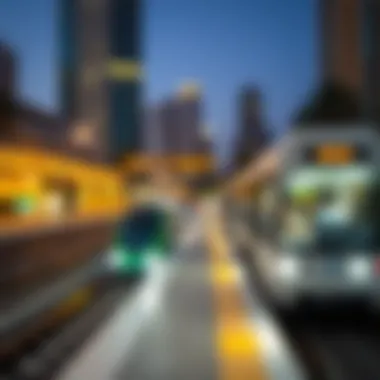
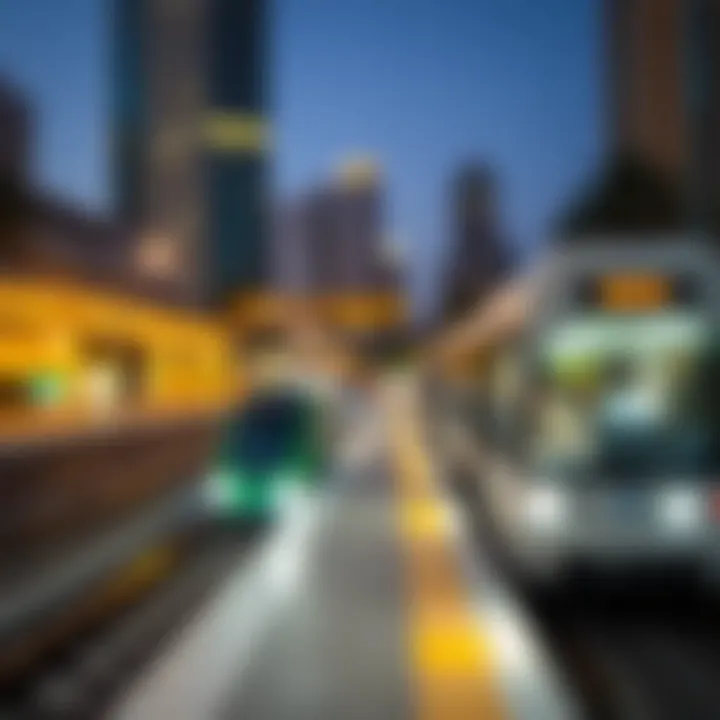
- Accessibility to Schools and Healthcare: Many families prioritize neighborhoods with quality educational institutions and healthcare facilities, both of which are often enhanced by nearby Metro access.
- Green Spaces: Connectivity to parks and open spaces contributes to a higher quality of life, which is increasingly sought after in urban settings.
- Cultural and Social Offerings: Areas with rich cultural experiences, restaurants, and entertainment options attract diverse demographics, fostering a dynamic community spirit.
In summary, the Dubai Red Line Metro serves as a catalyst for real estate development, shaping property values, investment opportunities, and lifestyle choices within the neighborhoods it serves. Recognizing these impacts can aid potential buyers and investors in making informed, strategic decisions as they navigate the ever-evolving Dubai real estate market.
Future Developments and Expansion Plans
The evolution of the Dubai Red Line Metro is far from over. With the city buzzing with growth and innovation, the Red Line is primed for further enhancements. Understanding the future developments related to this metro extension is pivotal. As the lifeblood of public transport, the Red Line is not just about connecting the city but also about bolstering economic growth, enhancing urban mobility, and setting the stage for real estate surges.
Upcoming Stations and Planned Expansion
Plans are afoot to introduce new stations along the Red Line, which will cater to the growing population in Dubai. Key proposed stations include the addition of Al Quoz and Dubai Design District, both of which are rapidly emerging as cultural and commercial hubs. Here’s a glance at some of the essential features of this expansion:
- Enhanced Connectivity: New stations are expected to provide seamless connectivity to other transport modes like the tram system and buses. This integration can enhance accessibility, making commuting smoother for residents and visitors alike.
- Increased Coverage Area: With more stations, the metro will expand its reach, ensuring that residents in the more suburban areas can access the metro easily. This is particularly attractive for those who may be considering moving further from the city center due to rising real estate prices.
- Sustainability Initiatives: The forthcoming expansions are likely to incorporate environmentally friendly features, aligning with Dubai's 2040 Urban Plan and its focus on sustainability. Stations may include solar panels and rainwater harvesting systems, showcasing a commitment to reducing urban carbon footprints.
This development is not merely about adding tracks or stations; it’s about rethinking urban mobility in a city that continues to grow at an unbelievable pace.
Anticipated Economic Impacts
When considering the future of the Red Line, it’s critical to acknowledge the anticipated economic impacts these developments could have on Dubai. The economic landscape is expected to shift significantly due to several factors:
- Job Creation: New stations and associated infrastructure projects are likely to create various job opportunities, from construction jobs during development to service-based roles in the long run.
- Increased Business Activity: With more stations, businesses are positioned to thrive. Retail spaces in and around stations are expected to attract more foot traffic, encouraging new shops, cafes, and restaurants to open.
- Boosting Tourism: Enhanced connectivity means that tourists will have easier access to attractions across Dubai. New stations at key spots can transform the way visitors explore the city, increasing the tourism sector's contribution to the economy.
According to a study from the Dubai Economic Council, such expansions can lead to a projected growth rate of approximately 5% in local business activities related to tourism and retail sectors.
Projected Changes in Real Estate Dynamics
Real estate dynamics in Dubai are intricately linked to public transport developments like the Red Line. As new stations are built, the effects on property prices and investment trends will be noteworthy:
- Rising Property Values: Properties within walking distance to new metro stations are projected to witness significant appreciation in value. The convenience of public transport often enhances property desirability, driving up prices.
- Emerging Neighborhoods: Areas that were previously overlooked, such as Al Quoz and the vicinity of the Dubai Design District, can see a substantial boost in development and resident interest. As such neighborhoods develop, they often attract young professionals and artists, creating vibrant new communities.
- Shifts in Demand Patterns: Traditionally popular areas might see a slowdown in property demand as new developments emerge nearer to metro lines. Investors should closely monitor these shifts and adapt their strategies accordingly.
"Investment in transport infrastructure lays the groundwork for urban regeneration and economic diversification, particularly in a dynamic market like Dubai."
For those keeping a keen eye on the situation, the implications of these developments will stretch far beyond mere transportation.
Sources:
The End and Key Takeaways
In wrapping up this exploration of the Dubai Red Line Metro, it’s crucial to emphasize the multifaceted nature of its impact within the urban landscape. The Red Line is not just a means of transport; it serves as a vital artery that connects various neighborhoods, fostering a sense of community while driving economic growth. Its effectiveness in easing traffic congestion and promoting sustainable urban mobility cannot be overstated. For anyone touching ground in Dubai—whether you’re an investor, a potential homebuyer, or a regular commuter—the rise of the Red Line has implications worth considering deeply.
Summarizing the Importance of the Red Line
The significance of the Red Line can be distilled into several key points:
- Accessibility: With its extensive network, the Red Line grants users unparalleled access to hotspots throughout Dubai, ranging from bustling commercial districts to tranquil residential areas. This easy access enhances the desirability of locations along and near the line.
- Economic Catalyst: As we've noted, the metro line supports local economies. Businesses experience higher foot traffic, which can lead to increased sales. An area’s proximity to a metro station frequently boosts its attractiveness for new businesses and startups.
- Urban Development: The metro's development has given rise to numerous projects that weren't on the radar before its inception. From residential to commercial developments, the metro has incited a boom in construction and investment.
- Sustainable Living: The Red Line contributes to a greener Dubai. By encouraging a shift from personal vehicles to public transport, it helps reduce carbon emissions and enhances the quality of urban life.
In essence, the Red Line is a pivotal component of Dubai’s urban framework, shaping the city’s current dynamics and future growth.
Final Thoughts on Investment Strategies
For those considering investment in property along the Red Line, several insightful strategies emerge from this research:
- Focus on Key Stations: Identifying stations with the potential for higher foot traffic can guide investment decisions. Areas like Burj Khalifa/Dubai Mall and Dubai Marina frequently draw attention and resources.
- Watch for Development Trends: Staying attuned to new announcements related to infrastructure and commercial developments near metro stations can offer clues to future property appreciation.
- Evaluate Lifestyle: Prospective buyers should consider not only property prices but also the quality of life. Access to the metro line can enhance living conditions, making areas more favorable for families and expatriates.
- Long-Term View: Real estate investments inevitably oscillate; thus a long-term strategy that aligns with the metro's growth trajectory is advisable. The benefits might not be evident overnight, but the trend indicates upward momentum with careful patience.










